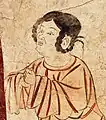Fist-and-palm
The Fist-and-palm gesture, also known as Gongshou (Chinese: 拱手; pinyin: Gǒngshǒu), or Zuoyi (Chinese: 作揖; pinyin: Zuòyī) in Chinese, is a traditional Chinese ceremonial gesture or salute used for greeting or showing respect. It involves bringing together the index finger, middle finger, ring finger, and little finger of both hands, with the palms facing inward or downward and the thumbs of each hand interlocking. One hand is placed over the other, and generally, the left-hand covers the right one for men and is reversed for women. There are different variants depending on conditions, such as gender, occasion and relationship between the individuals. and additional hand and body movements such as bowing may used with the gesture.[1][2][3]

History
The Gongshou gesture can be traced back to Zhou dynasty (1046 BC – 256 BC).[4] Imperial court of the Zhou dynasty established ritual and music system, which includes the earliest form of "Zuoyi" gesture. The system emphasized obedience and respect within the society, which helps the dynasty to centralize power within its patriarchal clan.[5]
Gallery
%E3%80%82.jpg.webp) College students in China performing a variant of fist-and-palm gestures.
College students in China performing a variant of fist-and-palm gestures. An illustration depicting Confucius with a variant of fist-and-palm gestures.
An illustration depicting Confucius with a variant of fist-and-palm gestures. A Tang dynasty mural depicting fist-and-palm gestures.
A Tang dynasty mural depicting fist-and-palm gestures.%E4%B8%BB%E5%B8%AD%E8%8E%AB%E5%81%A5.jpg.webp) The fist-and-palm is used during the COVID-19 pandemic by government officials in Taiwan as an alternative to handshake.[6]
The fist-and-palm is used during the COVID-19 pandemic by government officials in Taiwan as an alternative to handshake.[6]
See also
References
- 国家人文历史 (2020-05-06). "如果见面不能握手,你会选哪种古代礼仪代替?". k.sina.cn. Retrieved 2021-03-06.
- "Chinese Customs - Daily Rituals and Table Manners | ChinaFetching". ChinaFetching.com. Retrieved 2023-10-01.
- "Adviser urges China govt to use 'fist and palm' salute in times of pandemic". Hindustan Times. 2021-03-08. Retrieved 2023-10-01.
- "Chinese Etiquette: Fist & Palm Salute, Hand Greeting Gesture". www.topchinatravel.com. Retrieved 2023-10-01.
- "你了解古代真正的"见面礼"吗?". www.sohu.com. Retrieved 2023-10-01.
- Mittler, Barbara (26 February 2021). "Social Distance, Hygiene and the Handshake: a Chinese Perspective".